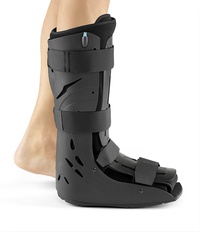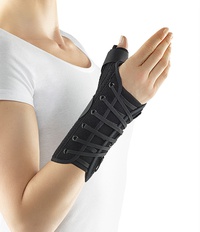Bone Fractures
What is a Bone Fracture?
The human skeleton consists of more than 200 bones. Some, like the thin but very long humerus, break easier than others. A fracture is usually the result of an accident, a fall or an impact when the bone is put under more pressure than it can handle. In the case of a fracture (also known as a bone fracture, a bone crack or a broken bone) one of the bones may be broken into several pieces. Furthermore, the bone fragments may be displaced. Repeated stress to the bone, for example from too much exercise, can also lead to a bone fracture. This is called a fatigue fracture or stress fracture.
What are the risk factors for Fractures?
Our bones are composed of water, organic material such as bone and cartilage cells, and various inorganic salts. The ratio between these substances changes over the course of a lifetime. The bones of children, for example, contain more elastic organic substances.

When an accident occurs, it is more common for the bones to splinter instead of break, which is called a greenstick fracture. In this case, instead of easily snapping in half like a dry piece of wood, the bone is comparable to a fresh piece of wood that is hard to snap in two, but instead splinters into smaller pieces where it's bent. The bones of an adult keep a good balance between elastic and inelastic materials in the bone substance. With advanced age, the level of minerals decreases and consequently bone breaks are more likely after minor accidents.
Certain factors may increase the risk of fracture. For example, osteoporosis develops when bone density is reduced. The small holes and spaces of the bone structure become larger. Under the microscope, osteoporotic bone looks like a porous sponge. As a result, this atrophy of the bone leads to a loss of stability. Osteoporosis is often a sign of aging, but it also happens to young people. Tumors could also damage the bone and weaken its structure. But diseases aren't the only things that can cause fractures. Aging also naturally increases the risk of fractures. A 70-year-old has a five times higher risk of fractures than a 20-year-old.
How do Broken Bones heal?
There are five phases of fracture healing. The fracture phase marks the single moment the bone breaks, followed by the forming of a hematoma at the fracture gap. During the inflammatory phase, which lasts two to three days, the body increasingly creates blood vessels in order to supply the fracture with all the materials required for bone healing.
In the course of the subsequent granulation phase, the hematoma solidifies with the help of the granulation tissue and forms a "callus", which serves as a soft connection between the fragmented pieces of bone. This phase ends after three to four weeks, followed by the formation of a hard callus. The formerly soft bone then solidifies thanks to a mineralisation process which produces woven bone. In the final modelling and remodelling phase, this specific bone structure is slowly replenished by normal bone tissue.
At this point, the healing process of the fracture is complete. With the help of a sufficient cast, brace or supportive bandage, this highly effective process allows our body to heal a bone fracture within a few short months.



